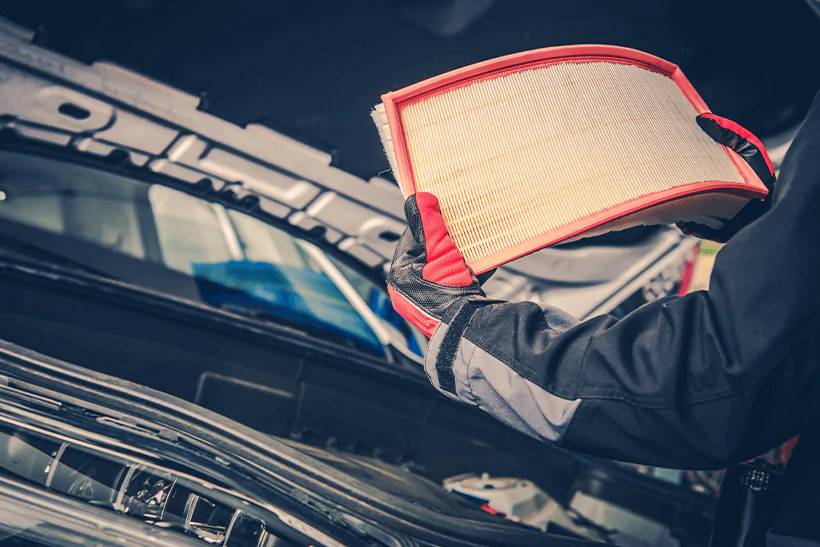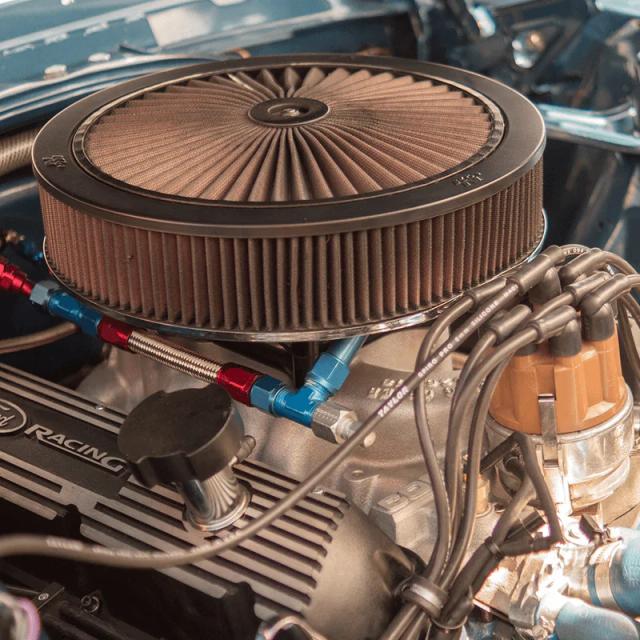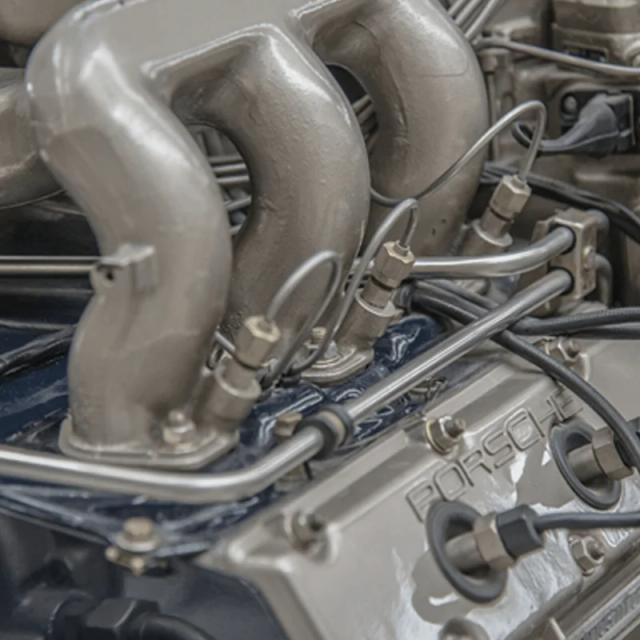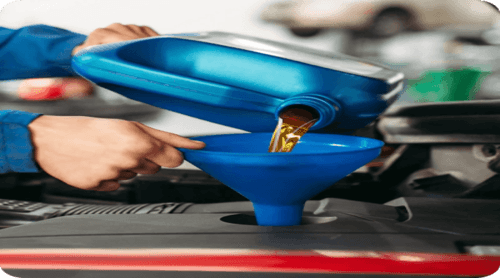
A dirty or failing air filter is one of the most common problems affecting your engine's performance. Whether you're a dab-hand with auto repairs or have a little basic knowledge, it can be too easy to forget about cleaning and checking the air filter, and it's often tricky to know when to change it. To help you, we have put together this handy guide. We will cover:
What Does an Air Filter Do in a Car?
How Often Should I Change My Air Filter In My Car?
What Happens When You Drive a Car Without an Air Filter?
7 Symptoms of a Faulty Car Air Filter
How to Check Your Air Filter
How to Clean Your Air Filter
How to Change Your Air Filter - 5 Simple Steps
Air Filter Know-How
What Does an Air Filter Do in a Car?
Your car engine uses a mixture of oxygen and fuel to complete the combustion process, which is responsible for powering your vehicle. This means that air filters are essential for engine health and can typically have one of two benefits. The primary purpose is to keep the engine parts free from debris, whereas the other kind has deeper pleats to allow for increased airflow and, therefore, better combustion.
If you know you need a new air filter, just head over to our air filter page. Enter your reg number or make and model and we’ll locate the one suitable for your vehicle.
There are three main types of engine air filters. The air filter you choose can impact how often you'll need to maintain it or whether you can clean and reuse your air filter. These include:
Paper Filters
These are the cheapest and most common air filter types used nowadays. However, paper air filters are not always the best choice. Instead, they are better suited to small cars and driving in locations with little dust and debris. It's important to note that these aren't reusable and must be replaced often.
Gauze Filters
These can be washed and reused and are available in two different types: oil gauze and synthetic dry. The oil gauze ones are the most popular and need maintenance every 5000 miles.
On the other hand, the synthetic ones require cleaning more often than this with a specialist solution. You will need to check a gauze filter every couple of months to see whether it's dirty, and then you will have to clean it. You will also need to keep them well-oiled for better performance.
Foam Filters
You're unlikely to make a repair with a foam filter as they are designed to be for much smaller engines than cars, such as lawnmowers. However, some manufacturers may place a foam wrap over the air filter to create a barrier between particles, keeping the engine clean and running smoothly.
How Often Should I Change My Air Filter In My Car?
The best way to find out how often you should change your air filter is to consult your car's manual, which will detail how often your specific vehicle make and model will need air filter maintenance. However, if you've misplaced your handbook or have seen some contradicting information, you should generally change your air filter every 12,000–15,000 miles.
If you frequently drive in smoggy areas with lots of pollution, you are more likely to need to change your air filter sooner. This is because the dirtier the air outside, the quicker your air filter gets mucky. This can then cause breakdowns and result in costly damage. At the very least, cars driving every so often in these polluted areas must have their air filters changed yearly. But, if you drive very often in these places, your filters must be changed much more frequently.
If you need more clarification about changing your air filter, we recommend speaking to your car manufacturer's customer service team for specific advice about your vehicle.
What Happens When You Drive a Car Without an Air Filter?
The air filter keeps your engine healthy and the combustion chamber working correctly, so take out this essential part, and you're very likely to do some expensive damage to your engine or fuel delivery systems. Additionally, as your engine burns more fuel to compensate for the loss of oxygen, you'll also release excess toxic emissions into the atmosphere, damaging our planet and the air around you as you drive.
So, it pays to know when you have a faulty air filter so you can change it quickly rather than removing it and carrying on without one.
7 Symptoms of a Faulty Car Air Filter
Knowing when something's wrong with your air filter isn't always easy, as many symptoms overlap with other potential vehicle issues. But knowing the potential signals your car may give you when there's a problem with the air filter can help narrow down the possible causes. Below, we will be detailing some of the most common symptoms of a clogged air filter.
Reduced Fuel Efficiency
Any reductions in fuel efficiency is a clear sign that something is wrong with your vehicle, specifically that your air filter is clogged. This is because your air filter is responsible for keeping your engine free of debris, ensuring the combustion chamber has enough clean oxygen to mix with the fuel. So, when it's unable to do either of these things, you're bound to see reduced fuel efficiency.
If your engine receives less oxygen flow than is needed, it will try to burn more fuel to compensate for it, resulting in a smoking exhaust and more severe engine problems.
Misfiring Engine
Have you noticed it's taking your engine more to start working smoothly? If so, this could be down to a dirty air filter, causing a low fuel-to-air ratio. If you ever find yourself with a misfiring engine, the first place you should check is the air filter.
If your engine has too much fuel inside it, it can cause flooding in the engine and pollution of the spark plugs, both of which could create costly problems to repair.
There are plenty of other issues that could cause your car trouble when starting up, so ensuring you cancel out the air filter before you spend money getting everything else checked is important.
Rattling or Vibrating Engine
If your car is making some unusual noises, it could mean your air filter has become clogged. When the engine has enough oxygen flowing, you'd only ever hear a smooth hum, so any noise other than this means your ignition system is being starved of oxygen.
Illuminated Engine Light
Our car's communication systems are very good at telling us when something is wrong, so if you see the engine light illuminated, this could be your vehicle's way of signalling an air filter problem to you.
If impurities have been allowed to pass through to the engine, it will cause a build-up over time, triggering the engine light, and you're likely to notice reduced fuel efficiency and power.
Reduced Power
You may notice a power reduction when your engine isn't functioning correctly because it's getting gradually starved of oxygen. This could mean you're accelerating and not getting very far, or your car is making jerking motions, both of which would suggest a clogged air filter.
Exhaust Smoke
There are many types of exhaust smoke that your car can emit, but if your engine isn't getting enough oxygen, then it's likely to be black smoke you'll see. Not only can this cause a total engine breakdown, but the excess emissions are harmful to the planet, so you must check your air filter immediately to prevent any damage. You can determine what different exhaust smoke colours mean by checking out our exhaust smoke guide.
Strong Fuel Smell
When your engine is overcompensating for a lack of oxygen by burning more fuel, it's very likely your car will let off a strong fuel smell. This odour can mean you have a fuel tank leakage, but if it's also coupled with the presence of black exhaust smoke, you'll know to check your air filter.
How to Check Your Air Filter
First things first: you'll need to locate your air filter. In most new car models, you will find this inside a rectangular box known as the cold air collector box close to the front of the vehicle. This is typically just near the car part that frames your wheel well in the air supply system. However, this can differ from car to car, so again, consulting your vehicle handbook is advised to find exact details.
On older cars, the air filter will be found in the air cleaner, which can be found on top of the engine. It's usually a large, round shape with a pipe attached, which helps facilitate the movement of air to mix in with fuel in the combustion chamber.
There's quite a simple test to determine if your air filter needs changing in both new and old cars. Once you locate it, you'll need to lift it out (this should be easy to do, as it's not fastened down by anything) and hold it up against a bright light. If your air filter is fine, you should be able to see through it, but if not, you'll need to try tap some of the dirt off. Although it can be tempting, don't blow on the air filter to remove dirt, as this can damage it. Instead, gently tap the bottom side of it against something hard and repeat a couple of times.
If you still can't see through the filter after this, it may be time to clean it. If following the advice in the section below doesn't make your filter any clearer, you'll know it needs to be replaced instead.
How to Clean Your Air Filter
If your air filter looks clogged but you don't think it's ready for a complete replacement, you'll need to ensure you give it a good clean. You'll need to follow the instructions below to restore your air filter and keep it performing at its best for longer.
What you'll need:
A clean bucket
Water
Laundry detergent
A clean, lint-free towel or cloth
Method:
Fill your bucket with clean water
Add a small amount (about a quarter of a capful) of laundry detergent
Mix the detergent and water together
Submerge your filter in the water and swirl it around gently
Use the tips of your fingers to displace any dirt or dust that may be stuck to the filter
Once you're satisfied with the cleanliness of the filter, remove it from the water and shake any excess liquid out
Place it on the lint-free towel or cloth to air dry
How to Change Your Air Filter - 5 Simple Steps
If you've checked your filter and found that it needs changing, you'll be pleased to hear that this is quite a simple repair you can do yourself. Failing to change your air filter when required can result in your engine producing more exhaust smoke, which may cause your car to fail its MOT and decrease fuel efficiency. So, it's essential to change the air filter at the intervals recommended by the manufacturer.
To begin your repair, you'll need the following:
A correct replacement air filter for your car. If you have any trouble finding the correct one, we have a handy product finder tool you can use to discover the parts compatible with your exact make and model of vehicle
A clean rag or cloth
Once you've got the equipment needed, you'll then need to follow the below steps:
Step 1 - Locate the Filter
First, you'll need to locate your air filter. If you followed the previous steps in our How To Check Your Air Filter section, you'll already know its location. But, if it's your first time looking for it, read your owner's manual or research your car's make and model to find out where it is.
Before you look for your filter, you must ensure your engine is completely cool, and your car is parked on level ground with the handbrake on to prevent any injuries or accidents.
Step 2 - Release the filter
Once you've located your air filter, you must remove it carefully according to the manufacturer's instructions. This might involve releasing catches, holding it in, or lifting open some components from your air filter supply system.
Step 3 - Remove the filter
Carefully lift the filter out of its compartment, paying attention to any clips you may need to undo before removing it.
Step 4 - Wipe Down the Filter Housing
Get rid of any dirt and debris inside the engine air filter housing by removing the compartment that holds the filter and wiping it down with a clean cloth or rag.
Step 5 - Fit the New Filter
Once the housing is all dusted down, you can put the filter compartment back and slot the new air filter in – just compare the old and new air filters to ensure your replacement is a perfect fit. You'll also need to check for any markings, showing you which way to put the new filter in.
Air Filter Know-How
Your air filter is essential for the smooth running of your engine, so knowing how to diagnose problems with it and how often to clean, check, and change your filter is important. Here at GSF Car Parts, we have replacement filters, including air filters, and all of the car parts you'll need for the maintenance and repairs of your vehicle. This includes fuel and emission parts, those for your car's body and exhaust, and many more key replacement pieces.
Shop Air Filters at GSF Car Parts Online and In-Store
All our air filters are from trusted brands in the motoring industry, so you can count on them to be reliable and of excellent quality. Plus, our low-price promise means you can always expect great value, too.
We offer free UK delivery on all online orders over £25, plus 60-day returns*. We also know you want to get your car up and running as soon as possible, which is why we offer a Click and Collect service that allows you to get your new air filter in just an hour.
So, buy air filters from us with confidence today. Or if you're close to one of our 180 store locations across the UK & Ireland, drop by. Our experienced staff will be able to direct you to the correct part for your vehicle.





